Dimensions of kitchen tables: accepted standards, recommendations for selection and calculation
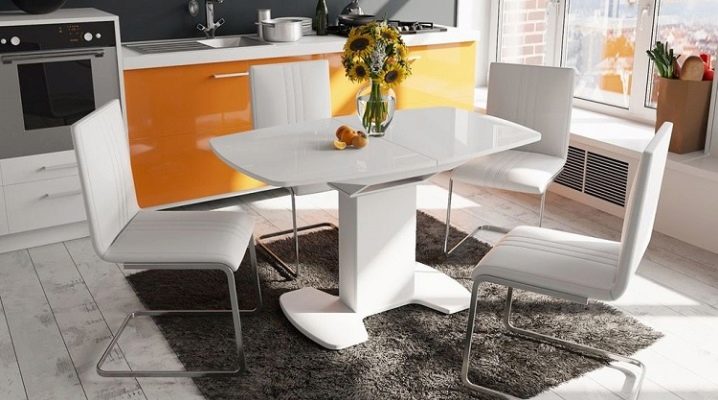
In the arrangement of the kitchen, the convenience of the household is of particular importance. For example, it is extremely important for them to be comfortable at the dining table, without depriving themselves of the atmosphere of home comfort due to the wrong size of furniture. The material in this article will acquaint the reader with the typical dimensions of kitchen tables and help simplify the choice of the optimal product by performing a calculation.
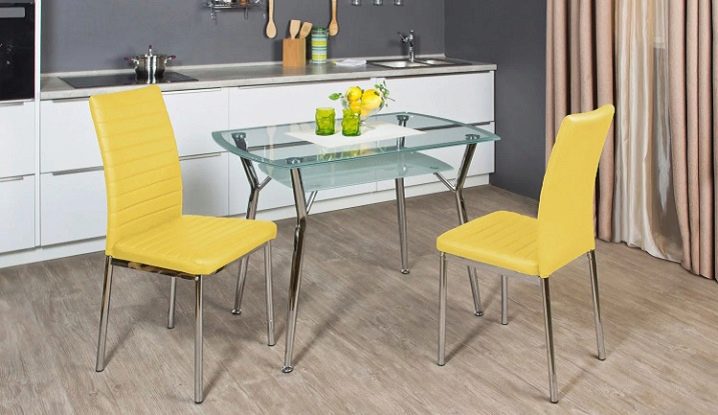
What are they?
Arriving at the store, the layman is offered standard options for kitchen furniture. The vast majority of dining tables have a typical height, which is the sum of the average height of a person, which is 165 cm. It is this height that prevails, since such products are easier to sell as a piece of furniture. However, despite the typical height, it is far from always convenient for most households.
If the table is low, users will have to slouch; if the table is too high, it will not be very convenient to eat while wielding cutlery. Of course, if furniture is purchased in the form of a ready-made dining group, this issue is resolved by purchasing chairs with a suitable height. However, often neither hypothetical norms, nor the experience of sellers and manufacturers are a guarantee of convenience. According to the established regulations, the optimal height of the kitchen table can vary from 72 to 78 cm.
In this case, the product should not have deaf side walls.
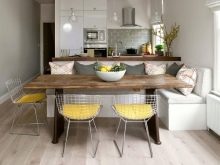
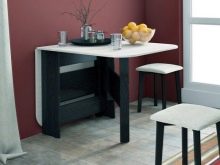

These figures mean the height together with the table top. In this case, the thickness of the countertop itself does not matter - the level at which it ends on top is important. As for the critical height mark to the bottom edge of the table top, it can be at least 61 cm from the floor. It is believed that in this case, the legs of the seated person will not rest against the lower surface of the tabletop. However, such a table is unlikely to be convenient for someone other than children.
For the cooking model, the standard height is 85 cm (typical size). Depending on the type of the headset itself, it can vary in the range of 86-91 cm from the floor level. These numbers are designed with work in mind when cooking, and are designed to reduce stress and fatigue from bent arms.
However, there are often cases when tables, like all furniture, are made to order, adjusting to the growth of a particular person.
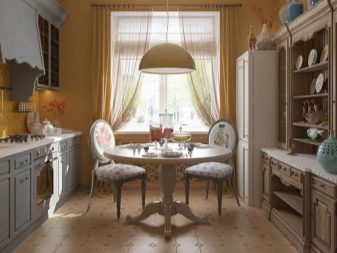
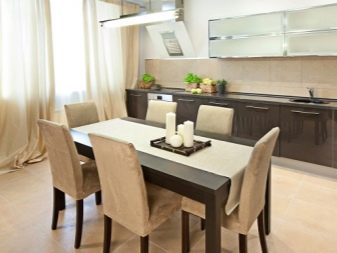
The dimensions of the countertop itself are variable: tables are small, medium-sized and large, designed for a lot of seats. The minimum options are able to accommodate one person. As a rule, these are products that are mounted in a kitchen set and unfold as needed. The sizes of such countertops can be different, more often they are narrow and have a rectangular shape. Such models can be attached to the wall, classic or hinged (built into the wall or wall cabinets of a kitchen set).
In conditions of limited space, the role of the table can be assigned to the bar counter. Today it is fashionable and allows you to use such a table as a kitchen divider into separate functional areas. It can accommodate from two to four people, although the degree of convenience for users in this case will depend not only on the height, but also on the availability of free legroom. Sometimes such tables are combined with working groups, they can be one- and two-tier.
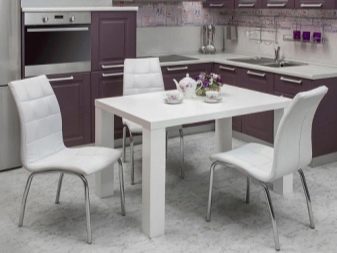
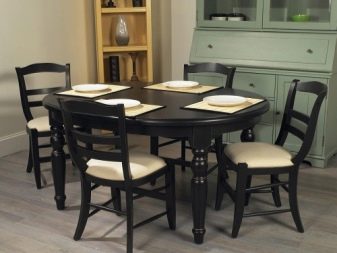
The shape of the products can be round, rectangular, square and even oval. Suspended structures often have a semicircular shape.Transforming tables can consist of several sections, which, if necessary, allows you to arrange behind them not only family members, but also a friendly company of friends.
At the same time, the increase in the tabletop when unfolding allows you not to huddle at the table, making friendly gatherings or family celebrations more hospitable.

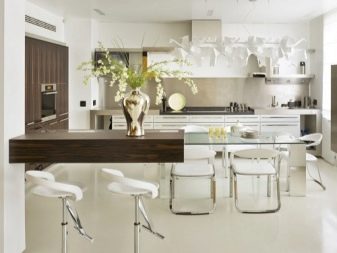
What do they depend on?
The size of the dining table in the kitchen may depend on the design features of the product. For example, the product can provide for the adjustment of the height and width of the table top. It can be either a mechanical module or a transforming table. Moreover, modification mechanisms can be very diverse: from X-shaped legs to retractable or electronic systems.
The convenience of such tables is the maximum comfort for household members. If necessary, you can choose the most optimal height in them, at which you do not have to hunch over or, conversely, reach for food. In addition, such products are practical and can be used in different functional areas of the kitchen.
The disadvantages of these designs are the high cost and reduced weight load on the countertop.


Tabletop parameters depend on the number of persons who need to be seated at the table. For example, for one user it is quite enough to purchase a table with dimensions of 50x50 cm. In this case, the structure can be sliding or folding. In conditions of a lack of quadrature, the table can also be attached (for example, this particular option can be purchased for a small studio-layout apartment).
The key criterion for choosing a kitchen table is the relationship between a person's height and the height of the countertop. It is believed that for tall users it makes sense to purchase a higher kitchen table. This rule also works in the opposite direction: the lower the family members, the more comfortable a table with a lower height will seem to them.
It is also important to note that the product is selected based on the growth of adult household members.
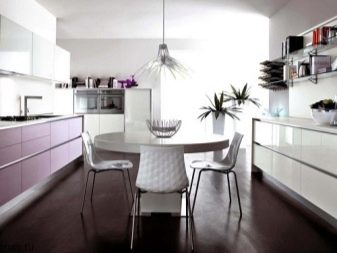

The height of the kitchen table is subject to its functionality. For example, if this is a dining option, it should be lower, because they are sitting behind it. Prepare food standing up - these tables are higher. In addition to these two categories, side tables, as well as tea and coffee options, which are often key elements of furnishing the guest space of kitchens, can decorate the interior of kitchens.
The lowest modifications are tables surrounded by sofas. Attached counterparts, in comparison with them, are higher, although their functionality is less. The height can be different, depending on what exactly it is planned to be used in the interior of the kitchen. For example, side tables can be used for fresh flowers, which is often the case in a classic style interior or country and Provence trends.


Also, in spacious kitchens-living rooms, tables can be used for placing additional lamps. As a rule, the height of the products in this case is also unimportant. However, at the same time, the height of decorative items should not be knocked out against the general background of furniture. If you plan to use the table as a tea table, you need to select the dimensions so as not to reach for the necessary cutlery.
As for mobile tables, which are often auxiliary elements of desktops, their heights are different. It is worth noting that the most convenient is the one that is closer to the height of the kitchen countertop. The height of the work table should be about 10–20 cm below the elbow.
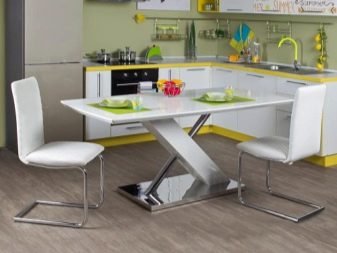
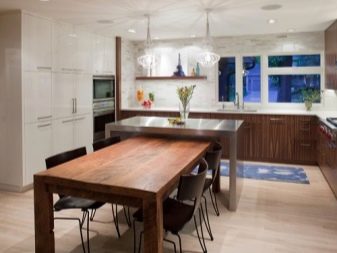
How to choose?
In addition to the height of the table itself, an important factor in the convenience of users will be the correct height of the chairs on which it is planned to sit at this furniture. For example, if the top edge of the tabletop is located at a distance of 72–80 cm from the floor level, the seat height should not exceed 40–45 cm. The higher the height of the seated person, the higher the chair seat should be from the floor level.
Despite the fact that the seller can assure you of the convenience of all the models available, most buyers rely on their own opinion. At the same time, some resort to the so-called fitting: they sit down at the table and try to put their arms bent at the elbows on it. With this fitting, they evaluate the degree of convenience of the position at the table. If the elbows do not hang, and the angle at the elbow joint is 90 degrees or slightly more, this indicates that the table height is sufficient and comfortable.
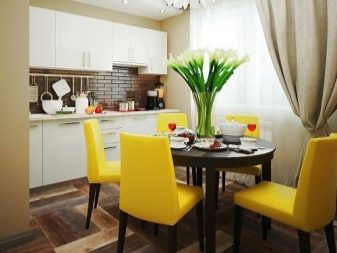
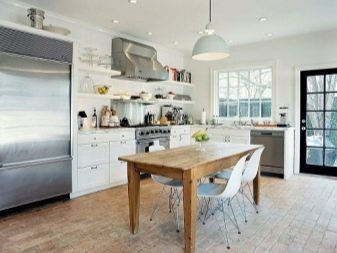
You don't have to bother with fittings and turn to already verified data. For example, depending on the purpose of the furniture, a sufficient table height for:
- washing dishes should not exceed 85–95 cm;
- the cutting of products can vary from 80 to 85 cm;
- cooking food can be 80–85 cm;
- kneading and rolling the dough should not exceed 82 cm;
- a table for installing small household appliances can be from 85 to 87 cm.
To answer the question of what should be the correct size of the kitchen table, you need to take into account the number of people for whom it is selected. On average, the standard width is usually 80 cm, but here the shape of the table can also be a decisive factor. For example, for comfortable placement at the table, a work surface of 40x60 cm is sufficient.If you need to place two households at the table, you should buy a product with tabletop parameters 80x60 (the minimum option), 90x60, 100x60, 100x70, 120x80 cm.
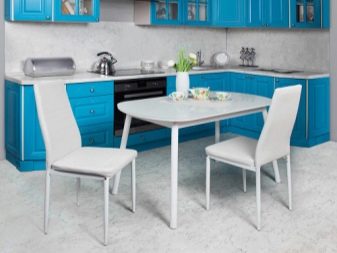
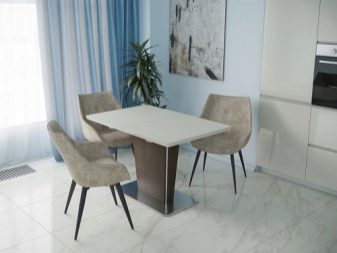
Of course, the depth of the table of 60 cm cannot be called the maximum convenient for two users, but sometimes it is the lack of usable space that forces us to resort to such solutions. The options for products with a width and length of 60x60, 50x70 and 70x70 are also cramped, but when users are located opposite each other on such countertops, you can fit the necessary dishes and food. Dimensions 60 by 80 (or 800x600 mm) are the standard parameters of floor modules, these are tables for cooking and washing.
So that a family of four can sit at the table, you will need a 150x50 cm table.A more hospitable table that will fit 8 people has tabletop parameters 110x200 cm.If you need an option for ten users, you should look at products with a length of 110 cm and a width 260 cm.If there are more persons, the length of the table will increase to 320 cm.
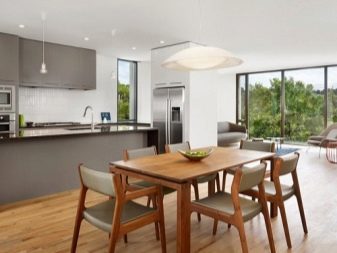
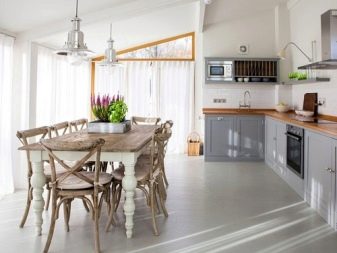
Small side tables have an average size of 40x40 cm. Folded tables can be folded 120x90, 60x90, 110x70 cm. When unfolded, they can double or triple the working surface. For example, a product of three sections in the open state can be 75x150, 75x190 cm. The sections can also be different (for example, the central part of the table top can be very narrow, for example, 35 cm, and the transformable ones - 70 cm each).
Round folding tables have two sections: these tables move apart to the sides. At the same time, the upper part, due to the inner section, can increase from 90 cm to 130 cm, stretching into an oval. Oval tables are laid out approximately according to the same principle. Side tables in ergonomic models can provide for the lifting of the work surface. Otherwise, they are more like pedestals, often with a functional lower part, in which there are shelves and drawers.
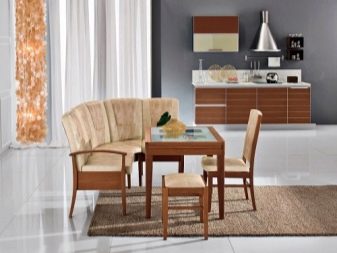
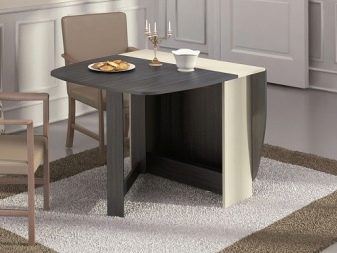
How to calculate?
There is a category of buyers who, when buying the optimal kitchen table, rely not on fitting, but on calculations. They carry out calculations according to the formula: H = R x hcp / Rcp, where:
- H is an indicator of the optimal size of the kitchen table;
- R is the height of the user for which this product is chosen, and the arithmetic mean can also be taken as a basis, based on the height of all adult household members;
- hcp is a typical height taken as a basis, which is 75 cm;
- Rcp is the typical height of an adult, taken as the basis for calculation, equal to 165 cm.
For example, in order to calculate the height for the user's height of 178 cm, we find the desired value as follows: H = 178x75 / 165≈81 cm.
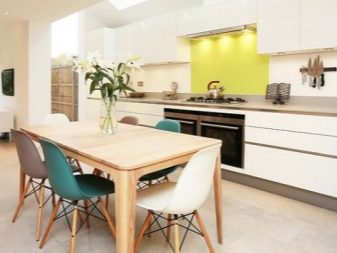

To learn how to make a wooden kitchen table with your own hands, see the video.













The comment was sent successfully.